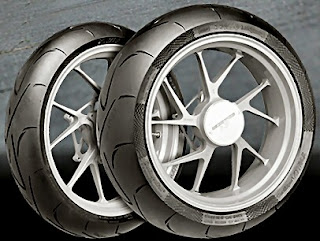Unidirectional Tyres: Musings
 Tyres, when it comes down to it, are a lot more difficult to understand than most other parts of a motorcycle. And, they also happen to be perhaps the most crucial part of the motorcycle as well. My sudden urge to think about rubber is not incidental though, having been prompted by this thread at bcmtouring. The first post says that a unidirectional tyre with a V-shaped tread had certain benefits and so forth. I write this not to slight the writer, but to correct some of the conclusions being drawn.
Tyres, when it comes down to it, are a lot more difficult to understand than most other parts of a motorcycle. And, they also happen to be perhaps the most crucial part of the motorcycle as well. My sudden urge to think about rubber is not incidental though, having been prompted by this thread at bcmtouring. The first post says that a unidirectional tyre with a V-shaped tread had certain benefits and so forth. I write this not to slight the writer, but to correct some of the conclusions being drawn.
First, the tread. Tread (and blocks and sipes) are added to tyres for one purpose and one purpose alone – to move standing water away from the interface between the rubber and the road. The only exception are knobblies, where the exaggerated height of each tread (knobble) allows the tyre to dig in a bit and provide grip where a loose/varying surface would not allow the generation of grip. If this were not the case (treads for water), the fastest machines would not yearn for slicks. And then dump slicks for treaded tyres at the hint of a cloud unable to hold it back any more. As far as the handling effect of the tread, I would like to believe that the tread design does not significantly affect the handling of the motorcycle. Compound, contour and profile have a lot more to do with handling than the shape of the tread blocks themselves. Yes, on really high performance machinery, tyres tend to have larger contact patches (bigger tread blocks) and fewer gaps in the tread because the tread flexing makes the bike feel funny (and smaller tread blocks also limit the amount of engine power than can be laid on the ground). Also, in really fast machinery, the water grooves are pretty large and there aren't any sipes and all because the tyre moving at optimum speed will be unable to utilise sipes.
Second, unidirectional tyres. From what I understand, uni-tyres are designed to give their best performance while rolling in one, specific, well-marked direction. Among the benefits are lower rolling resistance (heat losses generated by sidewall flex, not what you are thinking) and great overall grip. However, other resources also suggest that at least in bias ply construction (all of our motorcycle tyres so far), a unidirectional tyre also tends to resist ply separation (the ply layers peel off each other, I think) when rolling in the marked direction.
Third, the V-shaped tread. I was looking for a long time at the Unicorn's tyres and both tyres have V-shaped tread with the outside ends pointing backward. The middle point of the V arrives at water first and as the surrounding tread comes down, it forces the water into the V-channel, drawing it away from the contact patch. Simple. Central grooves, in my experience (I can't find any corroboration or denials) do help in the wet. Hell, I've cut grooves into the rear tyre with a hack saw blade and seen grip levels improve noticeably. Not dramatically, but noticeably. However, I have also seen uni-tyres that have Vs that point forward (as in the centre of the V arrives last). Since I can't find any technical explanation so far, I have to assume that at speed, the pressure of the tyre tread is enough to have the same effect in either direction of the V. If you know more about this... please post a comment?





















1 comment:
There was a time when I had done a lot of research on tyres.
Yes the centre groove has a role to play in channeling out the water. One reason the old MRF Zappers were so slippery on braking in the wet was because they didn't have any centre groove what so ever on the rear.
On most bikes clad with MRF Zappers the 'V's run opposite directions on the front and the rear. I guess this could be because the rear is the driving tyre while the front is the driven.
The rear grip comes into play when accelerating while the front one more in steering and braking. The forces on the two wheels are opposite. Guess that has the role to pay in the direction of the tread patterns.
Have you seen some (imported) tyres which can be fixed to both the rear and the front? They have opposite arrows showing opposite directions for front and rear fitment!
Post a Comment